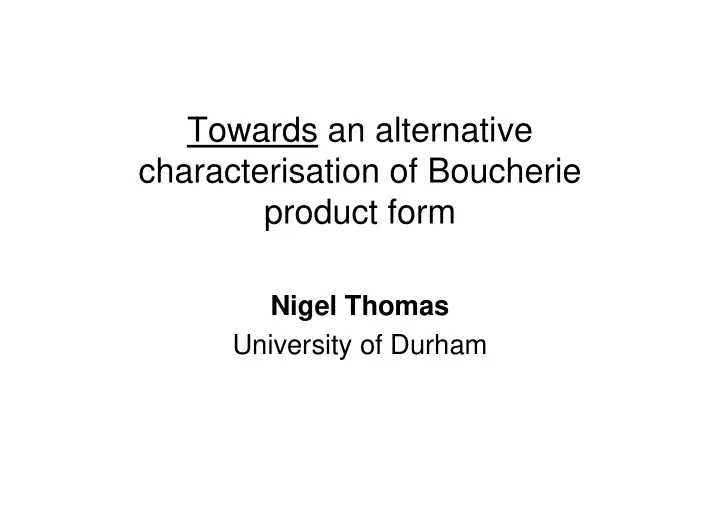

Towards an alternative characterisation of Boucherie product form Nigel Thomas University of Durham
Contents • Existing methods: Boucherie • Motivation • Mechanisms • Characterisations • Conditions for simple product form • Examples • Conclusions
Existing methods for stochastic process algebra • Product form – Reversibility / Quasi-reversibility (Harrison / Hillston) – Boucherie (Hillston) – Routing process (Sereno) – Queueing discipline (Clark) • Almost product form – Time scale decomposition (Mertziotakis / Hillston) – Synchronisation points (Haverkort / Bohenkamp) – Decision free processes (Mertziotakis) – Near independence (Ciardo / Trivedi) – …
Boucherie Product Form • Based on a number of components which only interact over a resource: – Certain actions can only happen with the resource. – If one component is using the resource another cannot, but may do something else. – The resource is explicit and redundant.
Motivation • Investigate intersection between different criteria for product form. • Allow characterisation of Boucherie type models without an explicit resource. • Investigate whether PEPA is really sufficient for this task.
Mechanisms • Behavioural Independence. • Partial Behavioural Independence. • Restricted Partial Behavioural Independence.
Characterisations • The simplest characterisation identifies models with the following structure: Changes in “B” Changes in “A” • Partial behavioural independence allows characterisation over multiple components: Changes in “C” Changes in “B” Changes in “A”
Characterisations (2) • Restricted partial behavioural independence allows characterisation over multiple interacting components: Changes in “B” Changes in “A”
Conditions for simple product form
Product form over components
Security Guards Example (1) • 2 guards, one must be on duty at all times, the other may sleep. + def T). G Awake ( aFallAslee p , r ). G Asleep ( bFallAslee p , G Awake A 1 A A def G Asleep ( wakeup , r ). G Awake A 2 A + def T). G Awake ( bFallAslee p , r ). G Asleep ( aFallAslee p , G Awake B 3 B B def G Asleep ( wakeup , r ). G Awake B 4 B > < G Awake G Awake A B { aFallAslee p , bFallAslee p }
Security Guards Example (2) • Guards may patrol together. + def G Awake ( goOut , r ). G Patrol ( aFallAslee p , r ). G Asleep A 5 A 1 A + T). ( bFallAslee p , G Awake A def G Patrol ( goBack , r ). G Awake A 6 A + def G Awake ( goOut , r ). G Patrol ( bFallAslee p , r ). G Asleep B 7 B 3 B + T). ( aFallAslee p , G Awake B def G Patrol ( goBack , r ). G Awake B 8 B > < G Awake G Awake { goOut , goBack , A B aFallAslee p , bFallAslee p }
Security Guards Example (3) • One Guard patrols but the other must be awake ( r 5 must equal r 7 ). + def G Awake ( goOut , r ). G Patrol ( aFallAslee p , r ). G Asleep A 5 A 1 A + + T T). ( goOut , ). G Awake ( bFallAslee p , G Awake A A def G Patrol ( goBack , r ). G Awake A 6 A + def G Awake ( goOut , r ). G Patrol ( bFallAslee p , r ). G Asleep B 7 B 3 B + + T T). ( goOut , ). G Awake ( aFallAslee p , G Awake B B def G Patrol ( goBack , r ). G Awake B 8 B > < G Awake G Awake { goOut , A B aFallAslee p , bFallAslee p }
Security Guards Example (4) • Guards may sleep regardless. + def G Awake ( goOut , r ). G Patrol ( aFallAslee p , r ). G Asleep A 5 A 1 A + T). ( bFallAslee p , G Awake A + def T). G Patrol ( goBack , r ). G Awake ( bFallAslee p , G Patrol A 6 A A + def G Awake ( goOut , r ). G Patrol ( bFallAslee p , r ). G Asleep B 7 B 3 B + T). ( aFallAslee p , G Awake B + def T). G Patrol ( goBack , r ). G Awake ( aFallAslee p , G Awake B 8 B B > < G Awake G Awake A B { aFallAslee p , bFallAslee p }
Further work • Generalisation to full Boucherie product form. • Formal relationships between decomposition methods. • Efficient application of methods. • Partial evaluation, real-time solution, … • Applications…
Recommend
More recommend